Kay's Cooking Corner
September 2-8, 2013
Kay Bona
This past week my husband and I took our family to Gaucho’s Restaurant for dinner. This isn’t a restaurant review so I won’t go into much other than it is truly a different dining experience, and one that requires you to love meat. We did enjoy it, but one of the things enjoyed the most was the simplest fare on the menu (which you don’t get), the grilled pineapple. It was great. If you have never tried grilled pineapple, you need to! It’s delicious and simple and I’ll tell you how to prepare it below, but first let’s explore pineapple a bit more…
Pineapple, named for its resemblance to a pinecone, is not native to Hawaii. It was spread by the Indians through South and Central America, and on into the West Indies before Columbus arrived. In 1493, Columbus found pineapples on Guadeloupe and carried them back to Spain, where they sailed around the world on ships that carried it for protection against scurvy. The Spanish introduced it into the Philippines, Hawaii, and Guam early in the 16th century. England began growing it in greenhouses for its fruit around 1720. Now Hawaii is one of the biggest Pineapple producing states.
Pineapples are fruits of bromeliads, rising from the center on a single spike surrounded by sword-like leaves. The pineapple plant is the only bromeliad to produce edible fruit. Pineapples weigh between four and nine pounds, but can reach up to twenty pounds. Waste parts left from canning plants, including the skin, core and ends, are used to make alcohol, vinegar, and food for livestock.
Pineapple health issues:
Long ago, pineapple juice was fermented into alcoholic beverages and used to alleviate body heat and fevers. It was also used externally to dissolve warts and painful corns.
Due to hefty amounts of natural acids and bromelain enzymes, large amounts of fresh pineapple should not be consumed at one time. But, these same juices aid in digestion, as they resemble natural gastric juices. Pineapple is also a natural diuretic, helps clear mucous from bronchial tissues, and its fiber aids in elimination.
Pineapple cooking:
Pineapple juice is excellent when used as a marinade. The juice tenderizes tough meats, and adds a taste of the tropics to recipes.
Bromelain enzymes in fresh pineapple cause gelatins to fail and dairy products to separate. Cooking nullifies the enzyme, so use canned in gelatin dishes.
Slicing off the green leafy top and standing the pineapple upside-down on the cut end for half an hour, will allow the sweeter juices on the bottom travel to permeate the rest of the fruit for a sweeter overall taste.
Fresh Pineapple Smoothie
In blender, add 2 cups fresh pineapple, 1 cup yogurt, 1⁄4 cup walnuts (optional) and honey to taste if you prefer a sweet smoothie. Blend until smooth; add more yogurt for a creamier texture.
Pineapple Chicken with Rice
Use fresh, or drain a can of sliced pineapple, reserving the juice. Mix juice with chopped fresh basil, parsley, and oregano, 1 clove of garlic, salt, and pepper. Pour over skinless, boneless chicken breasts in plastic bag; refrigerate for a few hours. Grill chicken until done. Place pineapple on grill and cook until hot. Serve with crisp mixed greens and hot, cooked white rice.
Grilled Pineapple
Cut peel off fresh, whole pineapple. Insert skewer vertically, into center, through the core. Grill over medium hot coals, turning frequently to prevent burning. Serve at once.



